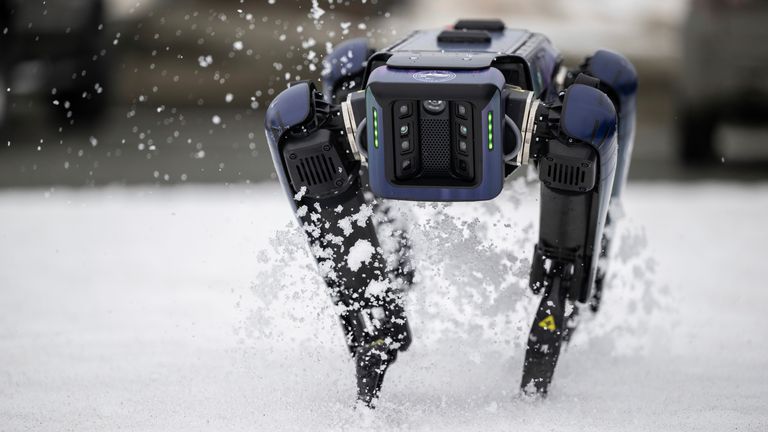Headless, dog-sized robot to patrol Alaska airport to prevent bird strikes
 Aurora, the robot, is adept at scaling rocks, ascending stairs, and executing graceful, dance-like movements illuminated by flashing green lights. These capabilities are strategically deployed to deter wildlife encounters.
Aurora, the robot, is adept at scaling rocks, ascending stairs, and executing graceful, dance-like movements illuminated by flashing green lights. These capabilities are strategically deployed to deter wildlife encounters.
By employing such tactics, Aurora aims to startle and discourage wildlife from approaching, ultimately mitigating potential conflicts between humans and animals.
A canine-sized, headless robot designed to resemble a coyote will be deployed at Alaska's second largest airport, the Fairbanks airport. This innovative measure, introduced by the Alaska Department of Transportation and Public Facilities, aims to bolster safety and operational efficiency by deterring migratory birds and other wildlife from the airport premises.
The headless robot, approximately the size of a Labrador, will be strategically camouflaged as a coyote, blending into the surrounding environment to discourage birds and wildlife from congregating in areas that pose a risk to aircraft operations. This novel approach represents a proactive step towards mitigating potential hazards associated with wildlife interference at the airport.
By enhancing existing wildlife management efforts with this innovative technology, the Alaska Department of Transportation and Public Facilities seeks to ensure the safety of both air travelers and airport personnel. Through the deployment of this coyote-inspired robot, the airport aims to minimize the likelihood of bird strikes and other wildlife-related incidents, thereby enhancing overall safety and operational effectiveness.
Photo description of the robot
 Photographs have been unveiled showcasing the robot, named Aurora, in action, demonstrating its ability to navigate rocky terrain, ascend stairs, and perform dynamic movements reminiscent of dancing, accompanied by flashing green lights.
Photographs have been unveiled showcasing the robot, named Aurora, in action, demonstrating its ability to navigate rocky terrain, ascend stairs, and perform dynamic movements reminiscent of dancing, accompanied by flashing green lights.
These agile maneuvers will serve a practical purpose during migratory bird seasons, as Aurora will utilize its dancing capabilities to mimic predatory behavior, dissuading birds and other wildlife from roosting near aircraft infields. By emulating the movements of natural predators, Aurora aims to effectively deter birds and wildlife from congregating in areas that could pose a threat to aircraft safety.
Previous methods of wildlife deterrents have included unconventional measures such as releasing pigs near a lake close to the Anchorage airport in the 1990s, with the intention of reducing waterfowl populations by targeting their eggs near aircraft landing areas.
During the trial period in Fairbanks, the effectiveness of Aurora as a deterrent against larger animals will be assessed, including its response to potential encounters with moose and bears.
Conclusion
According to data from the Federal Aviation Administration, there were 92 reported animal strikes near airports across Alaska last year, with 10 incidents occurring in Fairbanks alone. While most of these strikes resulted in no damage to the aircraft, Ryan Marlow emphasized the potential dangers and financial costs associated with such encounters, particularly when birds are ingested into aircraft engines, which can lead to catastrophic crashes.
Mr. Marlow referenced a tragic incident in 1995 at Elmendorf Air Force Base in Anchorage, where an AWACS jet crashed after colliding with a flock of geese, resulting in the loss of 24 lives. This serves as a stark reminder of the serious consequences that can arise from wildlife strikes at airports.


































